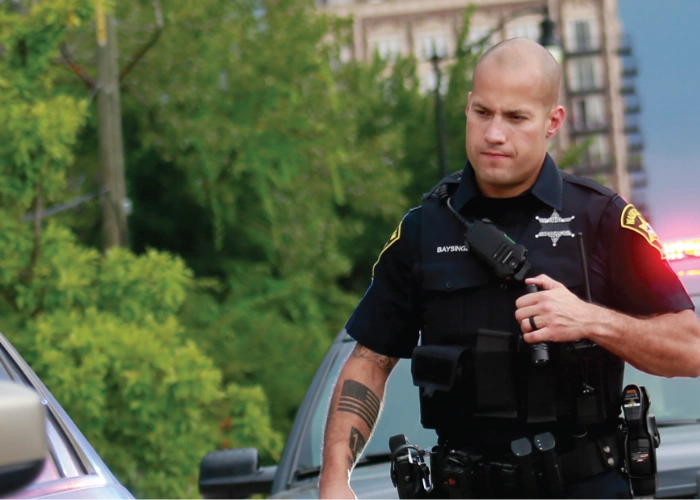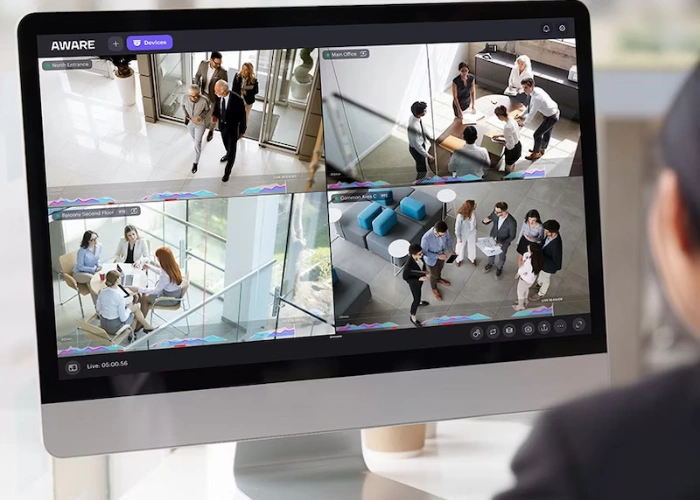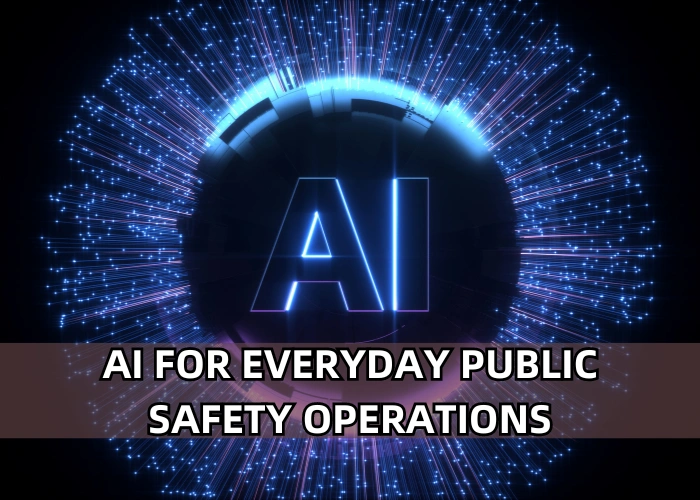Motorola Solutions is dedicated to improving safety and efficiency for communities and businesses. And we’re proud to be a leading Motorola Solutions channel partner. Motorola is focusing on making public areas and workplaces safer and more efficient through advanced technology.
Their “Solving for Safer” initiative plays a big part in this effort. This program uses Artificial Intelligence (AI) to help emergency responders and other professionals react quicker and more accurately to incidents.
The goal is to make environments safer for everyone by integrating smart technology into daily operations. This initiative is a key example of Motorola’s commitment to innovation and public well-being. And we’re so proud to be a part of it.
What Role Does AI Play in Public Safety?
No matter where you go these days, what radio station you turn on, or where you tune in to get your news, you’ll hear something about Artificial Intelligence (AI). And while there are some industries where AI may not be as welcome, the fact is that it is playing a key role in the public safety space.
Artificial Intelligence, or AI, refers to the technology that allows computers to perform tasks that usually need human intelligence. These tasks include recognizing speech, making decisions, and seeing patterns. In public safety, AI can quickly find important information in a sea of data or watch surveillance cameras more efficiently than humans.
Motorola Solutions takes the use of AI very seriously, especially in critical areas like public safety. They follow strict guidelines to ensure that their AI technology is used in a way that is fair, clear, and accountable. One key principle is always having a “human in the loop,” meaning AI assists people rather than replaces them. This ensures that decisions made in emergency situations involve human judgment supported by AI, combining the best of technology with human oversight.
Moreover, Motorola’s AI tools are designed to specifically fit into existing workflows, enhancing them without disrupting the necessary tasks that keep communities safe. This careful integration helps public safety professionals like law enforcement officers do their jobs more effectively. The result? AI becomes a powerful ally in maintaining safety and order.

Human-Centered AI Design
We know there are a lot of naysayers out there, who are not entirely convinced that AI is a good idea. They may believe that AI is more prone to error. That AI is going to take over jobs. Or worse, that AI will become an intelligent life form similar to what we say in Hollywood hits such as iRobot, Robocop, or even The Terminator. But it’s important to remember that these are simply symbols of the film world. The real side of AI ensures that humans remain at the core.
And we get the concern. We understand that in this word of ours, caution is abundant about the rise of AI. So, we need to focus on its role as a supportive tool rather than a replacement for human workers. This approach ensures that AI enhances human capabilities without overtaking them.
For instance, John Deere employs AI and machine learning to analyze soil samples and various agricultural data. This technology aids farmers by providing integral insights into optimal planting times and locations, thereby improving crop yields and farm efficiency.
Similarly, the University of California, San Francisco (UCSF) has developed an AI system that assists radiologists in analyzing mammograms. This AI helps pinpoint areas that may require closer examination, allowing radiologists to concentrate on potential issues and enhance the accuracy of their diagnoses. With about 240,000 cases of breast cancer diagnosed in the U.S. each year, this is a massive change in the game—and it can save lives!
Airbus has also embraced AI to enhance aircraft safety and maintenance. Their AI system analyzes performance data to predict when parts need servicing or replacement. This predictive maintenance ensures higher safety standards and reduces costs by addressing issues before they escalate.
In each of these cases, AI doesn’t replace human workers. Instead, it supports them by making their tasks easier, more effective, and efficient. By keeping humans “in the loop,” these AI applications empower professionals to leverage technology to achieve better outcomes without compromising the critical human touch in decision-making.
AI Enhancements in Emergency Response
In emergency situations, every second counts. Motorola’s Solving for Safer initiative uses AI to make 911 operations faster and more accurate, helping save lives. One way AI helps is by streamlining the way emergency calls are handled.
For example, when someone calls 911, AI can convert their spoken words into text instantly. This means that dispatchers can quickly see the important details of the emergency on their screens without having to ask the caller to repeat themselves. While we hope you have never had a place a 911 call due to an emergency for a loved one, think about this for a moment. If someone you care about has been in an accident, is having a heart attack, or is experiencing some other form of emergency, it’s human nature to panic. That can make it more challenging for you to articulate your need. And, it can be equally challenging for the dispatcher on the other end of the call to understand what you are saying.
AI can cut through the “noise” and speed up the process, as dispatchers can send the right help to the right place more quickly. AI can recognize critical words or phrases like “fire” or “help me” during a call. This helps dispatchers understand the situation faster and prioritize calls based on urgency. This means less time for emergency workers to get to the location to provide what could be life-saving assistance.
These AI-driven tools not only quicken response times but also improve the accuracy of the information being relayed to first responders. This means that when help arrives, they are better prepared for the situation, which can make a big difference in emergencies.
AI in Everyday Public Safety Operations
Moving away from high-stakes emergencies, AI also plays a big role in enhancing everyday public safety operations. This technology assists in urgent scenarios and simplifies and secures routine tasks that are fundamental to keeping communities safe.
Here are some specific ways AI is integrated into daily public safety duties:
- License Plate Recognition: AI can automatically read and check license plates against databases for stolen vehicles or those associated with wanted individuals. Officers can receive instant alerts if a match is found without manual input.
- Surveillance Efficiency: AI-enhanced cameras can continuously monitor public spaces, detect unusual activities, and alert authorities, meaning quicker responses to potential threats.
- Administrative Task Automation: AI technologies help reduce the time officers and staff spend on paperwork. For instance, AI can transcribe spoken reports into text, automatically filling in forms and reports. This speeds up administrative work and allows law enforcement personnel to spend more time in the field.
These AI applications streamline operations and reduce the chances of human error. As you can see, it doesn’t replace human duties—it simply makes it easier for humans to do their jobs.

Ethical AI Considerations and Community Trust
As we incorporate more AI into public safety, handling it with care is a non-negotiable to maintain trust within the community. Motorola Solutions is deeply committed to ethical AI use, setting strict guidelines to ensure their technology is effective but also respectful and fair.
Motorola’s Ethical Guidelines for AI Development include:
- Transparency: They ensure that everyone understands how AI works and what it’s used for.
- Accountability: Motorola is responsible for its AI systems. It ensures that these systems do what they’re supposed to and promptly correct any issues.
- Fairness: They design AI systems to be fair, ensuring that they don’t create or reinforce unfair bias against any group of people.
Building trust in the community means showing that AI is used in helpful and just ways. Motorola takes extra steps to engage with communities, listening to their concerns and explaining how AI technologies can improve safety while respecting everyone’s rights.
EMCI Wireless Advocates the Responsible Use of AI in Solving for Safer
As we look toward the future of public safety, AI presents promising advancements but faces certain challenges. Implementing these technologies requires careful planning to ensure they serve the community effectively and ethically. EMCI Wireless stands firmly behind Motorola’s “Solving for Safer” initiative as a forward-looking advocate for responsible technology use. We emphasize the importance of using AI thoughtfully and responsibly in public safety applications.
Looking ahead, we can anticipate further enhancements in AI that will continue to improve public safety and make it more effective. These advancements will likely include more precise analytics, deeper learning capabilities, and even more seamless integration into daily operations to create safer and more efficient communities.
Motorola’s vision for the future revolves around these innovations, pushing the boundaries of what AI can achieve in public safety. By supporting this vision, EMCI Wireless champions the cutting-edge use of AI and reinforces its commitment to fostering trust and reliability in these technologies.
Motorola and EMCI Wireless are dedicated to paving the way for a safer, smarter world where technology and human expertise combine to enhance the safety and efficiency of communities everywhere.
Want to learn more? Schedule a free consultation for your business today.






